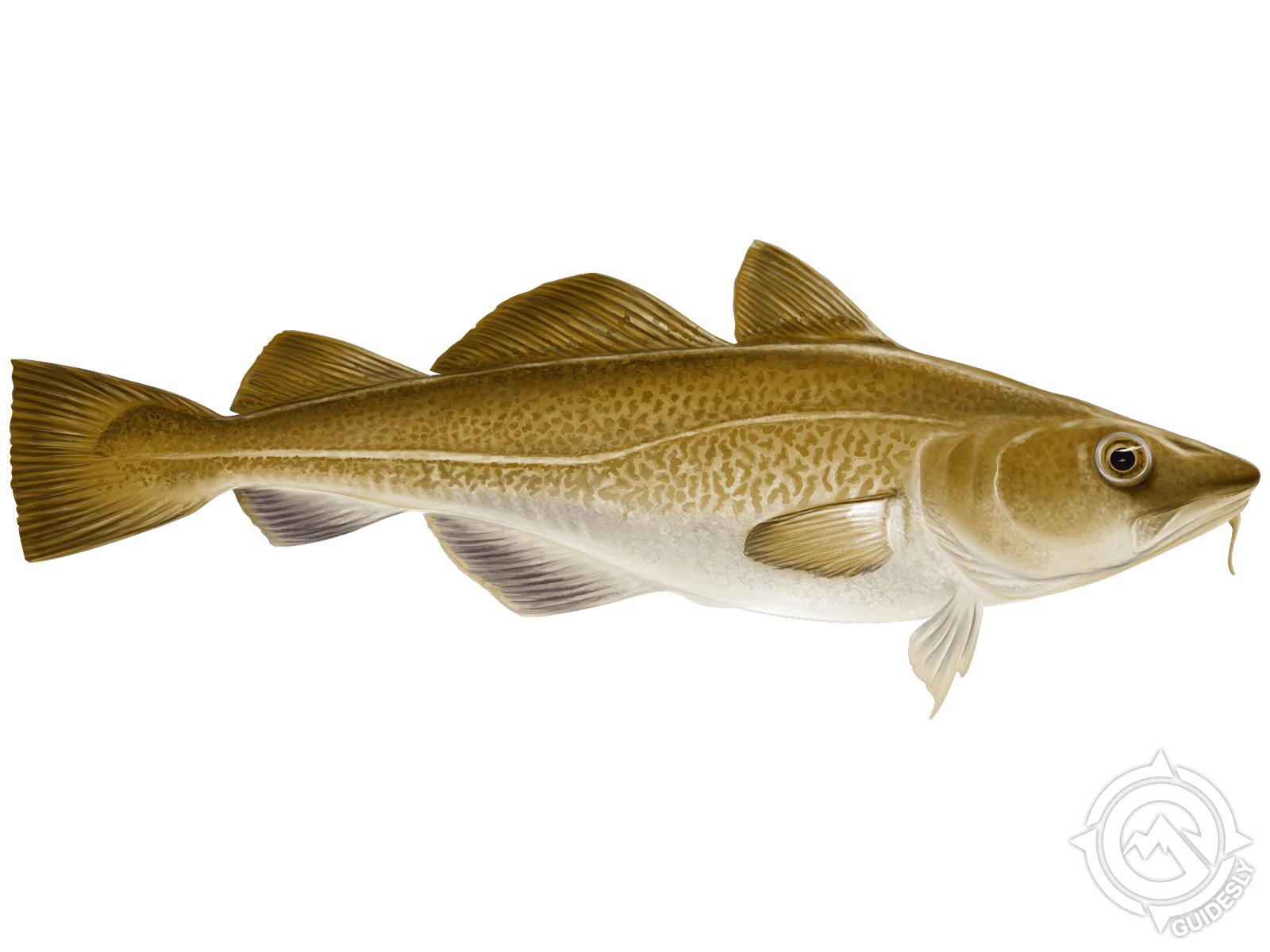Atlantic Cod

Species Details
Gadus Morhua
Gadidae
Gadiformes
Offshore, Ocean Floor
4 - 103 lbs.
48" - 60"
Atlantic Cod (Gadus morhua) Fish Description
The Atlantic Cod (Gadus Morhua) is a popular saltwater gamefish that can easily recognizable with the white lateral lines that run across each side of the length of its body. It has a rather disproportionately big head, a blunt nose, and a distinctive barbel (a sort of a whisker much like on a catfish) just underneath its lower lip. Its color usually depends on its habitat and can range from light yellowish-green to red and olive. It is covered with uneven spots in most parts of its body—including the head, tail and fins—except its belly, which is often light colored.
Atlantic Cods usually spawn between the months of January and April. The females can produce a whopping number of eggs of up to five million eggs per spawning season. When the eggs hatch, the young cods would just drift in the open ocean, feeding mostly on small crustaceans. When they reach adulthood, they would switch their diet to smaller fishes including herring, capelin, and sand eels; although they would still eat crabs, shrimps, and worms on occasion.
As one of the most popular fish used for food, the Atlantic Cod is widely targeted around the Atlantic—from the east coast in North America to Greenland, Iceland, as well along the coasts of western Europe—by both commercial and recreational fishers. Because of its delicate flavor and moist, flaky texture, its lean meat is regarded as one of the best. Unfortunately, this fish species has been heavily fished for centuries that its population has been on a steady decline, especially from the early to the latter part of the last century when fishing methods became more advanced.
NOAA Fisheries, however, has developed and implemented a 10-year rebuilding program in 2014 to help Atlantic Cod populations recover, particularly in our waters. The program has placed restrictions and regulations for both commercial and sport fishers, which includes: annual catch limits, size limits, and seasonal area closures.
Interesting Facts About Atlantic Cod
- The largest Atlantic Cod caught was five feet long and weighed one hundred three pounds.
- It was landed by a recreational angler Michael Eisele of Kiel, Germany.
- The monstrous Atlantic Cod was caught off the Norwegian island of Soroya.
- They can readily change their color according to their habitat.
- They can live up to thirty years in the wild.
- They are an important food source for Native Americans and early European settlers in North America, thus, regarded as an important driver of New World civilization.
- The species is now considered as vulnerable for extinction due to overfishing and climate change.
- Moratoriums are placed by authorities in key spawning areas to help the fish population recover.
Atlantic Cod Average Size and Swimming Speed
Even though there were lucky anglers who were able to catch 100-pounders, the Atlantic Cod grows from two to four feet in length and weighs up to eighty-eight pounds on average. It can also swim moderately fast at an average speed of 8.3 to 21.3 inches per second.
Where to Find Them - Habitat and Distribution
As the name suggests, the Atlantic Cod can be found far and wide across the Atlantic Ocean, specifically in cool temperate waters ranging from 0 to 200 degrees Celsius temperatures. They are a benthopelagic fish, which only means that they mostly live near the bottom, preferably in rocky and/or sandy environments; although they can sometimes be found swimming in midwaters or even near the surface to find food. They can be found at depths of 500 to 600 meters near the coastlines but can also travel to the open waters as well as brackish waters.
In the US, the Atlantic Cod is usually found off the shores of Maine and Massachusetts, particularly in Georges Bank and the Gulf of Maine. You can, however, also fish for Atlantic Cods as far south as off the shores of Cape Hatteras in North Carolina where is it is said to be also abundant with this prized fish.
Atlantic Cod Fishing Tips
Most recreational anglers who have caught Atlantic Cods were successful using live or dead natural baits, including: strip baits of squid, fish, crabs, sand eels, and capelin. They are also said to be drawn to clams, mussels, shrimp, and octopus. You can, nonetheless, also use artificial lures such as chrome diamond jigs, spinners, bucktails, spoons, and shiny metal squids. As Atlantic Cods are usually found offshore, you will also need to fish either from a drifting or anchored boat. For the gear, a 50-pound class rod paired with either a 30 to 50# braid line, equipped with 16oz bouncing sinkers will be more than enough to handle landing this fish.







